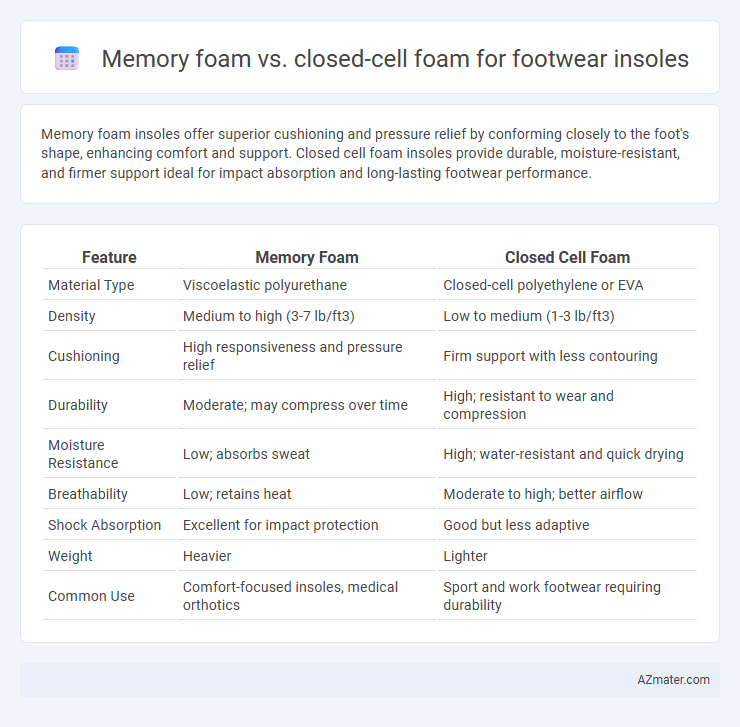Memory foam insoles offer superior cushioning and pressure relief by conforming closely to the foot's shape, enhancing comfort and support. Closed cell foam insoles provide durable, moisture-resistant, and firmer support ideal for impact absorption and long-lasting footwear performance.
Table of Comparison
| Feature | Memory Foam | Closed Cell Foam |
|---|---|---|
| Material Type | Viscoelastic polyurethane | Closed-cell polyethylene or EVA |
| Density | Medium to high (3-7 lb/ft3) | Low to medium (1-3 lb/ft3) |
| Cushioning | High responsiveness and pressure relief | Firm support with less contouring |
| Durability | Moderate; may compress over time | High; resistant to wear and compression |
| Moisture Resistance | Low; absorbs sweat | High; water-resistant and quick drying |
| Breathability | Low; retains heat | Moderate to high; better airflow |
| Shock Absorption | Excellent for impact protection | Good but less adaptive |
| Weight | Heavier | Lighter |
| Common Use | Comfort-focused insoles, medical orthotics | Sport and work footwear requiring durability |
Understanding Memory Foam Technology for Insoles
Memory foam technology in footwear insoles offers superior cushioning by conforming to the foot's shape, providing personalized comfort and pressure distribution. Unlike closed cell foam, which is denser and less breathable, memory foam uses viscoelastic properties to absorb shock and reduce foot fatigue effectively. This adaptive material enhances support and durability, making it ideal for prolonged wear and impact protection.
What is Closed Cell Foam in Footwear Insoles?
Closed cell foam in footwear insoles is a dense, non-porous material that provides excellent cushioning and support by trapping air within its sealed cells, which enhances shock absorption and durability. Unlike memory foam, closed cell foam does not compress as deeply, making it ideal for high-impact activities where stability and resistance to moisture are essential. Its water-resistant properties also prevent odor and bacterial buildup, contributing to improved foot hygiene and long-lasting comfort.
Comfort and Cushioning: Memory Foam vs Closed Cell Foam
Memory foam offers superior comfort by conforming closely to the foot's shape, providing personalized cushioning that reduces pressure points effectively. Closed cell foam delivers firm support and resilience with excellent shock absorption properties, maintaining stability during extended wear. For footwear insoles, memory foam excels in softness and contouring, while closed cell foam prioritizes durability and consistent cushioning.
Durability and Longevity Comparison
Closed cell foam insoles exhibit superior durability and longevity compared to memory foam, as their dense, non-porous structure resists compression and moisture absorption, maintaining cushioning over extended use. Memory foam, while initially offering enhanced comfort through pressure distribution, tends to break down faster due to its open-cell design, leading to reduced support and quicker deformation. For long-lasting footwear insoles, closed cell foam is preferred in durability-critical applications, ensuring sustained performance and resilience against wear.
Moisture Resistance and Breathability
Closed cell foam excels in moisture resistance due to its dense, non-porous structure, preventing water absorption and keeping footwear dry. Memory foam offers superior breathability with its open-cell design, allowing air circulation that enhances comfort but may retain moisture longer. Choosing between the two depends on balancing moisture control from closed cell foam with the breathable cushioning of memory foam in insoles.
Support and Shock Absorption Differences
Memory foam insoles provide superior shock absorption by conforming to the foot's contours, distributing pressure evenly and reducing impact forces. Closed cell foam offers firmer support with higher density, resisting compression and maintaining shape under prolonged use, which benefits stability and arch support. The choice between memory foam and closed cell foam depends on whether cushioning (memory foam) or firm support and durability (closed cell foam) is prioritized for foot comfort and injury prevention.
Weight and Flexibility in Insole Materials
Memory foam insoles offer superior flexibility by conforming closely to the foot's shape, providing enhanced comfort and pressure relief. Closed cell foam insoles, known for their lightweight properties, deliver greater durability and resistance to moisture, making them ideal for long-lasting use. When choosing between the two, memory foam prioritizes adaptive cushioning, while closed cell foam emphasizes minimal weight and structural support in footwear insoles.
Ideal Use Cases for Memory Foam Insoles
Memory foam insoles excel in providing superior cushioning and pressure relief, making them ideal for individuals with plantar fasciitis, arthritis, or those who spend long hours on their feet. Their ability to conform to the foot's unique shape supports better arch alignment and reduces impact on joints during walking or running. Memory foam is best suited for casual wear, athletic shoes, and orthopedic footwear where comfort and adaptive support are priorities.
Best Applications for Closed Cell Foam Insoles
Closed cell foam insoles excel in moisture resistance and durability, making them ideal for athletic and outdoor footwear where sweat and environmental exposure are common. Their firm support and shock absorption qualities benefit high-impact activities, providing enhanced cushioning and protection. These insoles also offer excellent insulation and maintain structural integrity over time, suitable for work boots and hiking shoes requiring long-lasting comfort and foot stability.
Which Insole Foam is Right for Your Footwear Needs?
Memory foam insoles offer superior cushioning and contour to the shape of the foot, providing personalized comfort ideal for everyday footwear or people with sensitive feet. Closed cell foam insoles deliver excellent durability, moisture resistance, and support, making them suitable for athletic or work shoes where impact absorption and resilience are essential. Choosing the right insole foam depends on balancing cushioning needs with durability requirements, ensuring optimal foot support and long-lasting comfort.

Infographic: Memory foam vs Closed cell foam for Footwear insole
 azmater.com
azmater.com